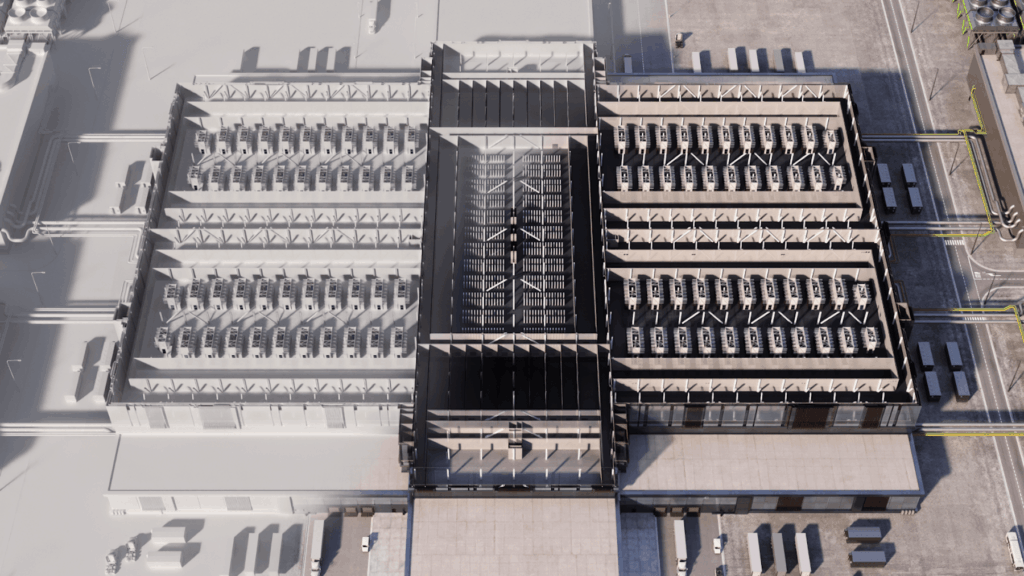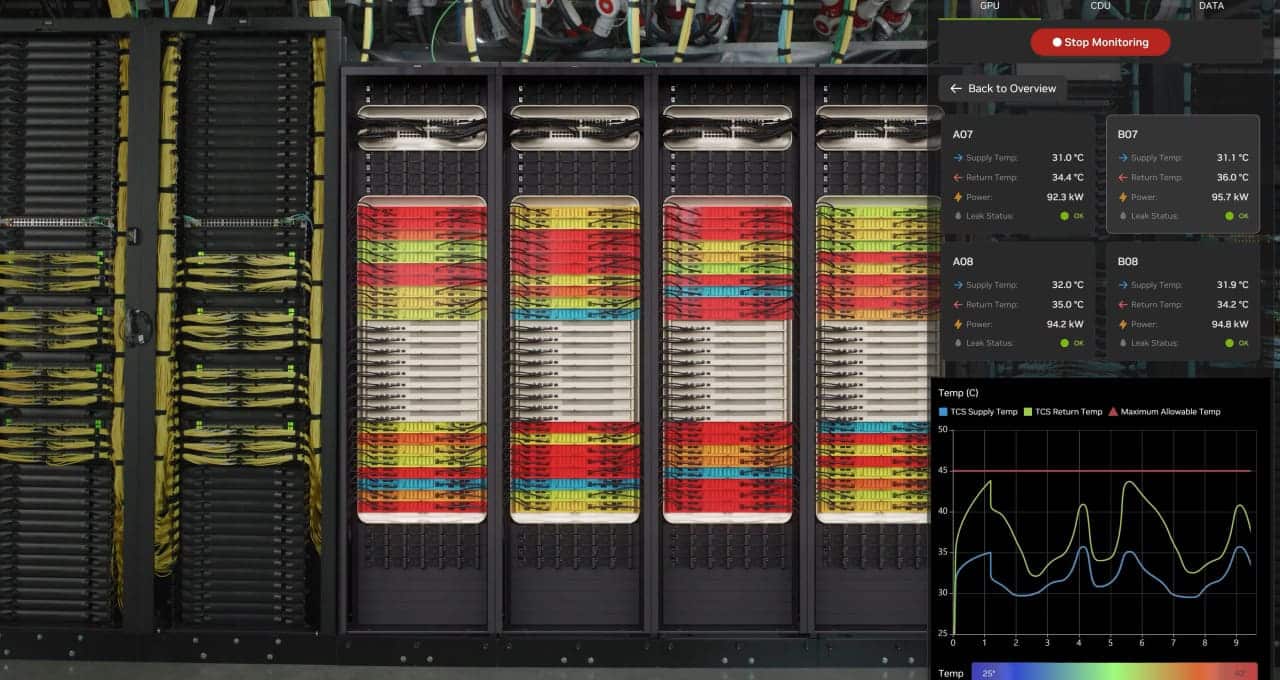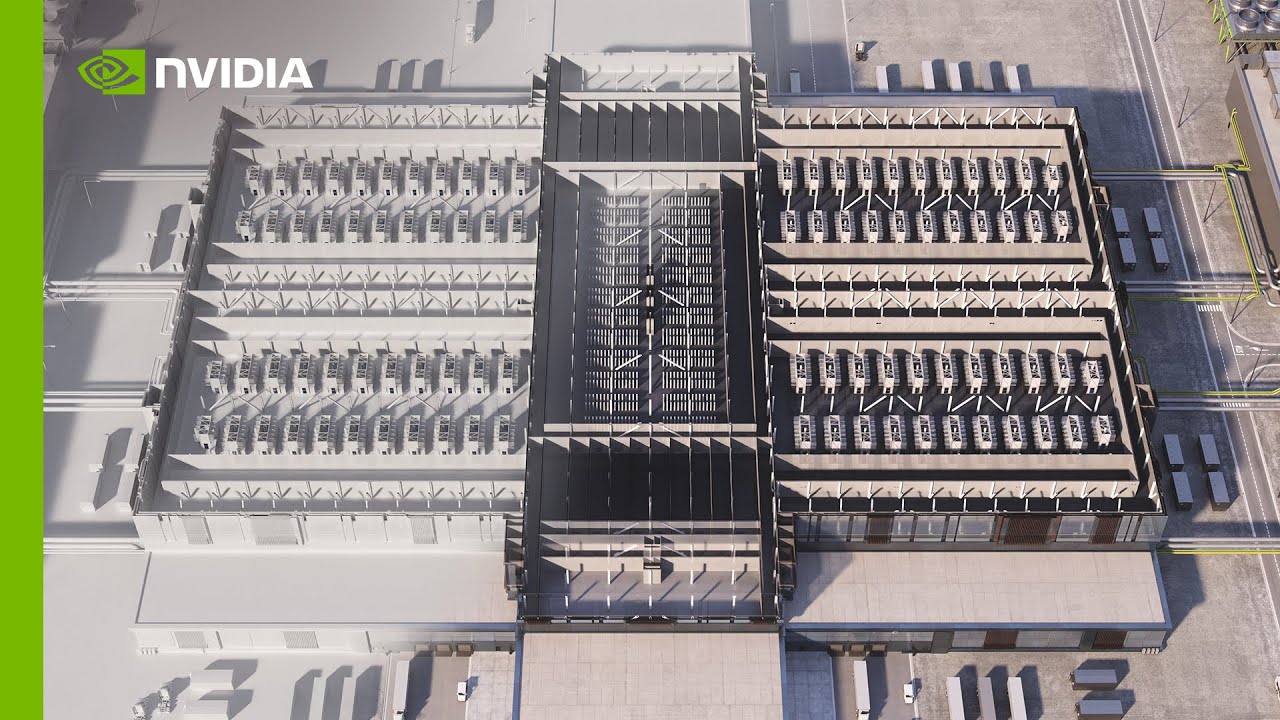At their GTC keynote, NVIDIA has unveiled Omniverse DSX, an open blueprint for designing, building, and operating AI factories ranging from 100 megawatts to several gigawatts. The plan —validated at the new AI Factory Research Center located on the Digital Realty campus in Manassas— aims to establish a standard that can be reliably reproduced to accelerate from the digital twin to operation with AI agents and autonomous control.
The key innovation: for the first time, building, power, and cooling are co-designed alongside NVIDIA’s AI infrastructure stack, and the entire process at the Virginia center is captured as a scalable and repeatable “recipe” proven in a real deployment.

From Virtual Blueprint to Plug-in Modules: How DSX Works
- Start with the digital twin. Using OpenUSD and Omniverse libraries, partner Jacobs designs the building and optimizes compute density and layout to maximize throughput (tokens) within power constraints.
- SimReady catalog. Siemens, Schneider Electric, Trane Technologies, Vertiv, and others contribute OpenUSD SimReady assets (power, electricals, cooling) that are integrated into PTC’s PLM, enabling multidisciplinary teams to collaborate in real time on photorealistic 3D models with version control.
- Physically realistic simulation. The blueprint adds on Cadence Reality Digital Twin, which incorporates Omniverse libraries and accelerates thermal and electrical simulations with CUDA for high fidelity: testing designs, predicting failures, and optimizing before construction.
- Modular construction. Bechtel and Vertiv supply prefabricated modules, manufactured and tested off-site, arriving ready to plug in, reducing construction time and facilitating block-level scaling.
- Self-optimizing operation. Once operational, the digital twin functions as an operating system: AI agents from Phaidra and Emerald AI, trained on the twin, optimize power, loads, and cooling in real time, reduce grid stress, and transform the factory into a self-learning system.
Three Pillars of the Blueprint
- DSX Flex — Dynamic Network Collaboration. Adjusts demand based on grid conditions using telemetry from Omniverse and AI agents, helping to leverage part of the roughly 100 GW of underutilized capacity.
- DSX Boost — Performance per Watt. Elevates NVIDIA’s energy optimization technologies to the data center level, operating loads at Max-Q (optimal performance/-W) for up to 30% more GPU throughput within the same power envelope.
- DSX Exchange — Unified IT/OT. A secure data and control fabric that links operational systems (power, cooling, security) with NVIDIA’s software stack and the Omniverse twins via real-time APIs and partner integrations.
Why it matters: scalability (pattern from 100 MW to multi-GW), efficiency (tokens per MW), sustainability (adaptive balance with renewables), and integration (unifying twin, facility, and operations).
An End-to-End Ecosystem
DSX brings together energy and equipment specialists —Eaton, GE Vernova, Hitachi, Schneider Electric, Siemens/Siemens Energy, Trane, Vertiv— with software and AI platform providers —Cadence, Emerald AI, Phaidra, PTC, Schneider Electric ETAP, Siemens, Switch— to cover the entire design → construction → operation cycle. The use of OpenUSD and Omniverse libraries ensures interoperability across models and simulations throughout the value chain.
Context: U.S. AI Factory Roadmap
The DSX blueprint is part of a broader initiative with national laboratories and companies to elevate the country’s AI capacity:
- Argonne (IL): constructing Solstice, the DOE’s largest AI supercomputer, with 100,000 Blackwell GPUs, and Equinox with 10,000 GPUs (expected in 2026), together delivering about 2,200 exaflops of AI. Argonne also adds three NVIDIA-based systems (Tara, Minerva, Janus) to broaden AI computing access.
- Los Alamos (NM): selecting the Vera Rubin platform and Quantum-X800 InfiniBand for their Mission systems (ATS5, 2027, classified) and Vision, focusing on materials, climate, and quantum computing.
- AI Factory Research Center (VA): will be the first Vera Rubin infrastructure, serving as the foundation for the DSX blueprint and a testing ground for digital twins and large-scale simulation.
Major server/cloud providers —Cisco (Nexus N9100 with Spectrum-X), Dell, HPE, Supermicro— and clouds/model builders (Akamai, CoreWeave, Google Cloud, Lambda, Microsoft, Oracle, Together AI, xAI, among others) are aligning investments to deploy AI factories and high-speed fabrics validated by NVIDIA.
What Changes for AI Data Center Builders
- Design with “shared truth.” A single twin (OpenUSD) with SimReady assets reduces iterations, risk, and decision time in architecture, power, and cooling.
- Shorter time-to-revenue. Prefabrication and pre-validation on the twin accelerate commissioning and modular expansion.
- AI-enabled operation. Optimization agents for energy and load and network cooperation improve resilience and efficiency without sacrificing throughput.
- Performance per Watt. DSX Boost enables increasing tokens without increasing MW, critical in stressed electrical grids and ESG goals.
In a Nutshell
Omniverse DSX turns the design and operation of AI factories into a replicable industrial process: from digital twin to construction, and from construction to a self-optimizing operation. Its goal is to maximize tokens per megawatt and shorten the journey from idea to operational capacity.
Sources (selected):
— NVIDIA, Omniverse DSX Blueprint (GTC Washington).
— NVIDIA, NVIDIA and Partners Build America’s AI Infrastructure and Create Blueprint to Power the Next Industrial Revolution.


